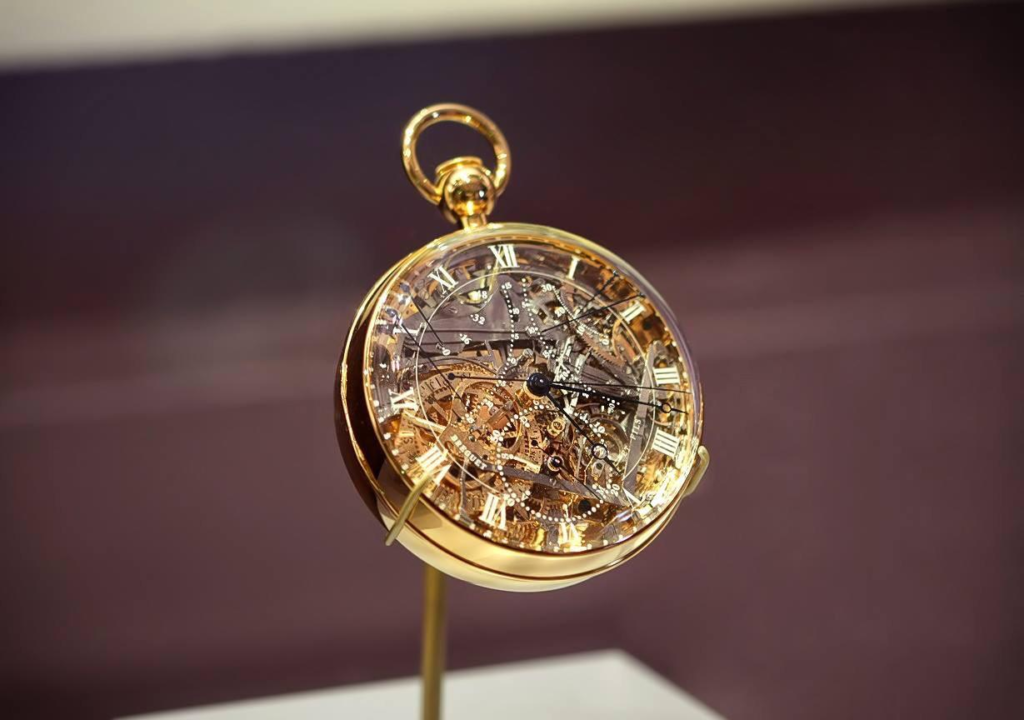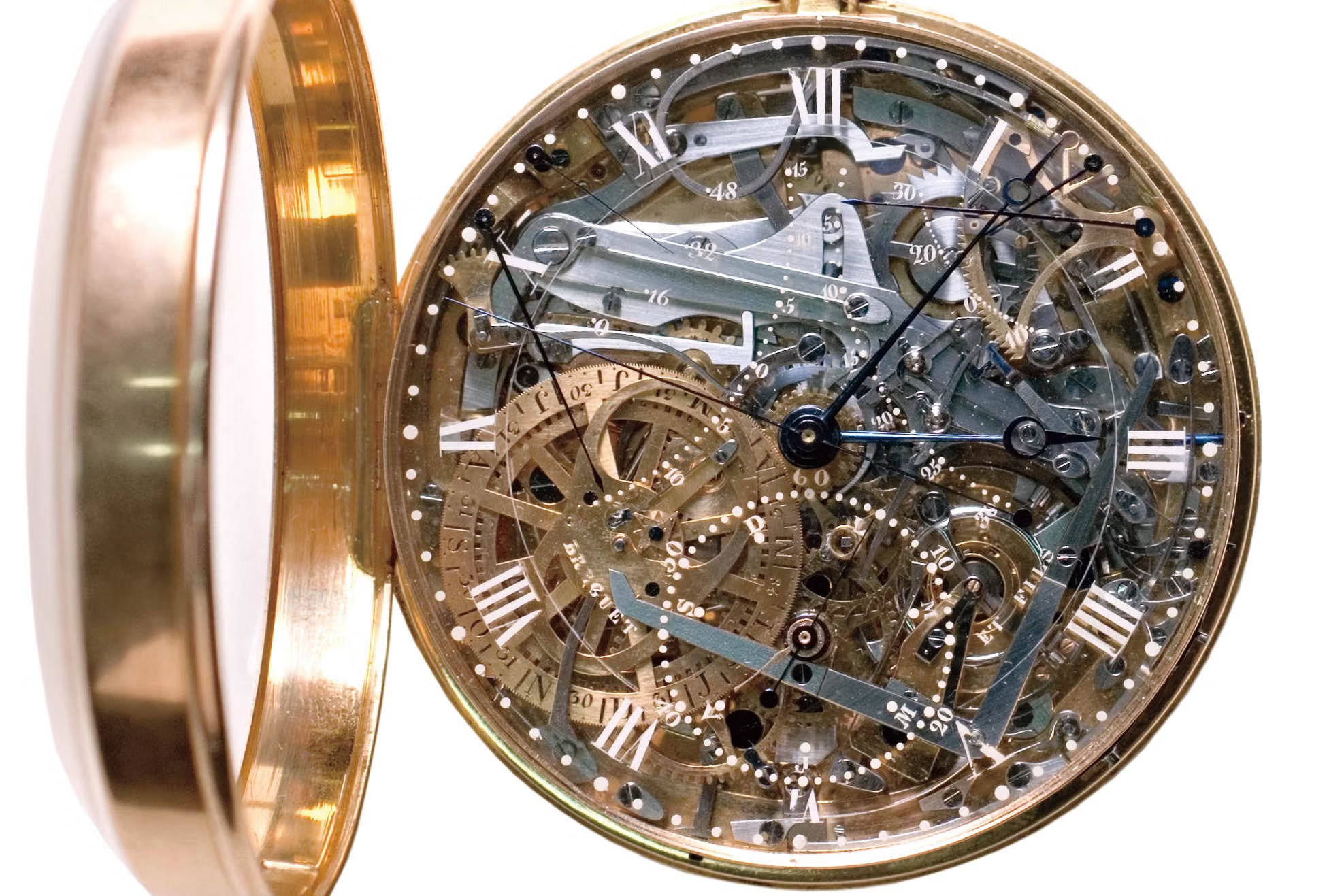A remarkable symbol of history, artistry, and horology, the Marie Antoinette Jewelled Watch, created by Abraham-Louis Breguet, is set to mesmerize visitors at London’s Science Museum.
The watch, famously known as “the grand complication,” boasts an intricate design featuring 823 parts made from the finest materials such as rubies, sapphires, platinum, and gold.
As part of the museum’s “Versailles: Science And Splendour” exhibition, this masterpiece will be displayed for the first time in the UK, beginning on December 12.
Marie Antoinette and the Legacy of an Extraordinary Jewelled Watch
Marie Antoinette, the last queen of France, remains an enduring figure of fascination in world history. Born in Austria in 1755, she was married off as a child bride to the future King Louis XVI of France.
Her life, marked by opulence and controversy, tragically ended at the guillotine during the French Revolution in 1793. The Marie Antoinette timepiece reflects the splendor of her era, combining unparalleled luxury with groundbreaking engineering.
Commissioned in 1783 by an admirer of the queen, the watch’s creation spanned decades, outlasting both Marie Antoinette and its maker, Abraham-Louis Breguet. Completed in 1827, four years after Breguet’s death, the watch became a timeless relic of the pre-revolutionary French monarchy.
Read : Tesla Car Catches Fire in France, All 4 Inside Burnt Beyond Recognition
Nicknamed “the grand complication,” the watch incorporates features that astonish even modern horologists. These include a perpetual calendar that accounts for leap years, a thermometer, an independent second hand functioning as a stopwatch, and on-demand chimes for the hour, quarter-hour, and minute. Its transparent crystal dial showcases the intricate mechanisms, highlighting a union of scientific ingenuity and artistic mastery.
A Watch of Remarkable History and Intrigue
The journey of the Marie Antoinette timepiece is as captivating as the history of its intended recipient. For nearly 200 years, the watch remained an object of reverence, embodying the golden age of horology. However, in 1983, this treasured artifact was stolen from the LA Mayer Museum for Islamic Art in Jerusalem, leaving the horological world devastated.
Read : Wine, Romance, and More: France’s Enchanting Travel Hotspots
For over two decades, the whereabouts of the timepiece remained a mystery. Its rediscovery and safe return to the museum in 2008 marked a significant moment in the preservation of history. Now, for the first time since its recovery, the watch has ventured abroad to become the centerpiece of an extraordinary exhibition at London’s Science Museum.

Sir Ian Blatchford, director and chief executive of the Science Museum Group, described the watch as “one of the most remarkable items we have ever secured.” He highlighted how the timepiece encapsulates meticulous engineering, dedication to knowledge, and an appreciation for beauty—qualities that resonate deeply with the exhibition’s themes.
David Rooney, author of About Time: A History Of Civilisation in Twelve Clocks, hailed the Marie Antoinette watch as “the world’s most famed watch” and “a true masterpiece.” Its presence in London offers visitors a unique opportunity to witness this icon of history and craftsmanship.
The Versailles Exhibition: Science and Splendour
The Marie Antoinette watch will be a part of the “Versailles: Science And Splendour” exhibition, which promises to transport visitors into the scientific and technological advancements of 17th and 18th-century France. The exhibition explores the role of science at the royal court and how monarchs such as Louis XIV, Louis XV, and Louis XVI harnessed technology to bolster France’s prestige and influence.
Spanning 120 years of scientific evolution, the exhibition will feature over 100 objects, many of which have never before been displayed in the UK. From astronomical instruments to intricate timepieces, these artifacts demonstrate the fusion of science, art, and power that defined Versailles.
Among the highlights is the story of how technological advancements were used to enhance the grandeur of the Palace of Versailles. Monarchs employed scientists and engineers to develop innovations, such as the palace’s elaborate fountains, which became symbols of France’s engineering prowess. The exhibition sheds light on the intersection of science and spectacle, revealing how these innovations served both practical and propagandistic purposes.

The exhibition will run until April 21, 2025, offering visitors a chance to delve into the opulent world of Versailles and the scientific pursuits that underpinned its splendor. Tickets are priced at £12, with free entry for children aged 11 and under, ensuring accessibility for families and history enthusiasts alike.
A Celebration of Artistry, Science, and History
The Marie Antoinette timepiece stands as a testament to the heights of human creativity and craftsmanship. Its display at the Science Museum not only celebrates the legacy of its creator, Abraham-Louis Breguet, but also serves as a poignant reminder of the cultural and scientific advancements of pre-revolutionary France.
For horologists, history buffs, and art enthusiasts, the opportunity to see this watch up close is unparalleled. Beyond its technical marvels, the timepiece evokes the grandeur and eventual downfall of an era. It tells the story of a queen whose life was marked by luxury and tragedy, a craftsman whose genius transcended his time, and a society on the brink of transformation.
This exhibition is more than just a showcase of artifacts; it is an invitation to explore the interplay between science, art, and power. It underscores the enduring allure of innovation and beauty, reminding us of the timeless nature of human ingenuity.
let’s enjoy few years on earth with peace and happiness….✍🏼🙏

